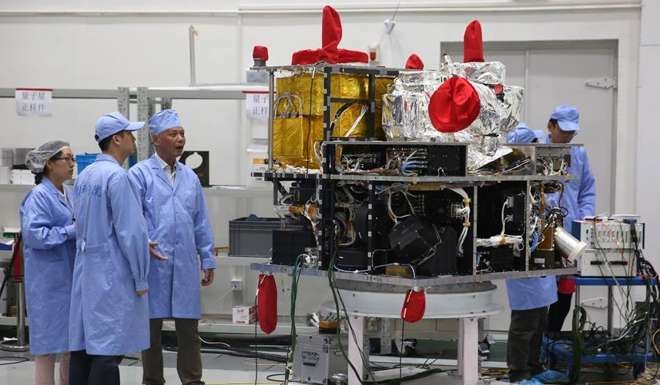
Chinese scientists solve quantum communication’s ‘nocturnal curse’, paving way for sending of secure messages 24/7
Using photons with a longer wavelength makes long-distance transmission possible during daylight hours
A breakthrough by Chinese quantum satellite researchers could pave the way for a “constellation” of hack-proof satellites capable of transmitting secure messages 24 hours a day.
In a recent ground-based experiment on Qinghai Lake, in northwestern China, they found a solution to the “nocturnal curse” that had restricted quantum satellite activities to nighttime.
The researchers, from the University of Science and Technology of China (USTC) in Hefei, Anhui province, beamed single photons carrying quantum information over a distance of 53km during daylight hours, several times longer than the previous daytime record and with unprecedented signal quality.
“Our work proves the feasibility of a low-Earth-orbit quantum satellite constellation which works mostly in the daylight,” the researchers, led by Professor Pan Jianwei, said in a draft paper released on the website arXiv.org earlier.
The quantum satellite constellation would help China build a “global-scale quantum communication network”, they added.

Pan’s team developed the world’s first quantum satellite, Micius, which was launched into orbit in August. It was designed to use the laws of quantum physics to achieve unbreakable communication, and China, intrigued by the military and economic potential, invested heavily in the technology.
Micius uses photons in various quantum states to transmit encrypted information. But such photons are almost invisible in daylight, with the useful signals lost in background noise. That meant the satellite has only been able to operate at night, and it could take up to three days to transmit a message from Beijing to the Chinese embassy in Washington.
The USTC team solved the problem by tweaking the photon’s wavelength.
Light’s behaviour can be described either as a particle or a wave. Human eyes can see light with wavelengths of between 400 and 700 nanometres, with most of the light produced by the sun falling within that range.
The wavelength of existing quantum communication technology falls between 700 and 800nm, very close to visible light and easily affected by natural light pollution.
Pan’s team developed a new system to produce and detect photons with a wavelength of 1,550nm.
The intensity of sunlight at 1,550nm is about five times weaker than at 800nm, which allowed the researchers to reduce the background noise to a very low level – only about 3 per cent of that experienced in earlier experiments.

That raised hopes for long-distance signal preservation, something essential for communication between satellites and ground stations. In previous experiments, conducted at ranges of about 10km, the chance of losing a signal was one in a hundred. But in the 53km experiment on Qinghai Lake, the researchers managed to reduce to loss ratio to 1/10,000, which they said was good enough for satellite communication.
However, single photon detection at 1,550nm is not easy, because the longer the wavelength, the weaker the photon.
“Despite the advantages of 1,550nm, researchers have been reluctant to use this wavelength due to the lack of good commercial single-photon detectors for the telecom-band,” Pan and his colleagues wrote in the paper.
The new technology would have wide applications, ranging from quantum key distribution networks to quantum teleportation, they added.
The paper is a manuscript that has yet to be peer reviewed, meaning the final version to be published in a research journal could feature changes.

“This is an important work. Free space quantum communication in daytime is every quantum physicist’s dream,” said a quantum technology researcher at Beijing’s Tsinghua University who was not involved in the research.
Single-photon detectors working at a wavelength of 1,550nm had been developed in other laboratories, but Pan’s team was the first to make the technology work in a harsh, outdoor environment.
“Qinghai Lake is on the Tibetan Plateau; it is very cold, very windy up there,” the Tsinghua researcher, who requested anonymity, said. “It is not easy to set up sensitive equipment for the experiment.”
But he said it could take years, if not decades, to take the technology into space because a lot more effort was needed to shrink the size of the devices and toughen them up for stable, long-term operation in orbit.
“A quantum satellite is an engineering pain,” he said.

